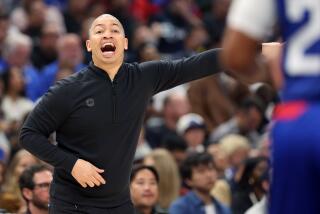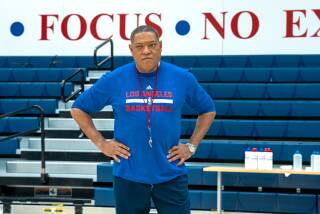Farewell, Coach Mike Dunleavy
- Share via
They’ll never forget Clippers Coach Mike Dunleavy, dangled out of a window two years ago by his owner, who lasted until Thursday -- time enough to turn the team’s roster around, if not its fortunes -- when he resigned.
With one year left on his contract at $5.4 million, Dunleavy will remain as general manager, the other half of the title he has formally held for two seasons.
If this is it as a coach, he leaves with one more distinction to add to an NBA Finals appearance (Lakers, 1991) and the Clippers’ first foray beyond the first round (2006):
Longest-serving lame duck in NBA history.
It has been two years, two weeks and a day since Jan. 21, 2008, when Clippers owner Donald T. Sterling vented his displeasure in an interview with The Times’ T.J. Simers.
With GM Elgin Baylor and President Andy Roeser present, Simers asked Sterling, who in happier times declared “I love Mike Dunleavy,” if he still loved his coach.
“I don’t think anyone really loves their coach,” Sterling said. “Do you think anybody loves their coach? They’re just a necessity.”
Since then, five coaches in their first full season have been fired (Phoenix’s Terry Porter, Sacramento’s Reggie Theus, Detroit’s Michael Curry, Charlotte’s Sam Vincent, Milwaukee’s Larry Krystkowiak).
In a major upset, Dunleavy wasn’t fired. Instead, he accepted the inevitable and resigned gracefully, thanking Sterling for his support.
This unprecedented stability in Clippers history while posting win totals of 40-23-19, plus 21 this season, was based on something more tangible than trust or affection: Dunleavy’s four-year, $24-million contract, which Sterling had no intention of paying off, no matter how upset he was.
It was probably what in 2008 set off the reclusive, soft-spoken Sterling, dismayed at the payoff he was getting, knowing he had two choices: Sit back and watch, or fire Dunleavy and pour that money down a hole.
It turned out to be the best money Sterling didn’t throw away because in the time that has passed, Dunleavy and his protege, personnel director Neil Olshey, turned the roster from old and creaky to young, talented and athletic, with a maximum salary slot for next summer’s free agents within reach.
The night in 2008 when Sterling went off, the Clippers started Sam Cassell, Corey Maggette, Tim Thomas, Quinton Ross and Chris Kaman.
Only Kaman remains. Rookie Al Thornton, who was on the bench, is the only other remaining Clipper.
More than making up for the losses of Maggette and the injured Elton Brand, who would leave in summer 2008, the Clippers have since acquired Baron Davis, Eric Gordon, Marcus Camby, Zach Randolph (and traded), DeAndre Jordan and the prize they pulled out of the Cracker Jack box but have yet to unwrap, Blake Griffin.
If the 2007-08 season was a seven-month bummer, it was a laugh riot compared with last season’s mail-it-in effort, which they finished at 19-63.
If any coach and any team needed a good start, it was them. Instead, Griffin was lost before the opener and Gordon eight games into the season.
With the team off to a 4-9 start, realizing his contract was losing its power as a protective force field, Dunleavy began a dialogue with Sterling.
“I called him after the bad loss to Phoenix on Christmas,” Dunleavy said Thursday. “I told him, ‘I’m working as hard as I can, I still think we have a team that can make the playoffs, but I understand the pressure you’re under. If you feel you have to make a move, I just want you to know I want to remain a part of this.’ ”
The Clippers righted themselves, showing they were an actual basketball team, climbing to 17-18, looking as if they could reach .500 on Jan. 12, leading the Grizzlies, 89-77, with :47 left in the third quarter . . . when the game was halted and the arena was emptied because of a broken water line.
When play resumed, the Grizzlies rallied to win, which turned out to be the first of 10 losses in the Clippers’ next 14 games.
Oh, and they also learned Griffin wouldn’t return this season.
With hope, and the team, fading, Dunleavy called Sterling after last week’s losses at 3-40 New Jersey and 9-38 Minnesota and says the owner was supportive.
When they returned from their 2-6 trip, Dunleavy had another in a series of similar conversations with Roeser. This time, all decided it was a good time to go. Assistant Kim Hughes is head coach for the rest of this season.
How long Dunleavy stays as GM remains to be seen. According to his contract, next season’s $5.4-million salary will be paid over two years, but the Clippers aren’t in the habit of paying GMs $2.7 million.
Actually, no Clippers exec ever made $0.7 million.
Of course, Dunleavy could accept a longer payout, say 2.7 million years.
In any case, he’s gone, but he’s still here and everyone feels good about it, closing a remarkable era in Clippers history, indeed.
More to Read
Get our high school sports newsletter
Prep Rally is devoted to the SoCal high school sports experience, bringing you scores, stories and a behind-the-scenes look at what makes prep sports so popular.
You may occasionally receive promotional content from the Los Angeles Times.






